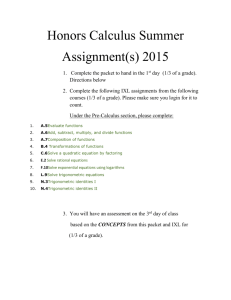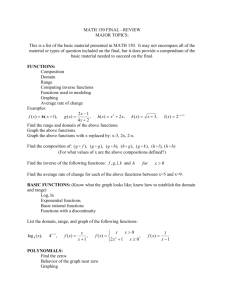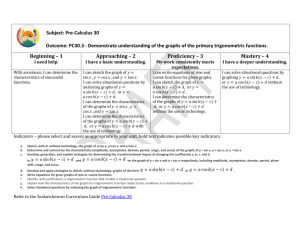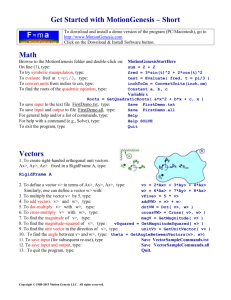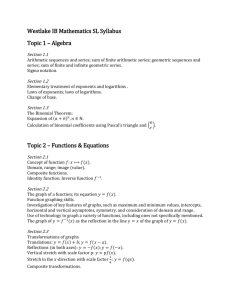Find the x- and y-intercepts, domain and range and sketch a graph
advertisement
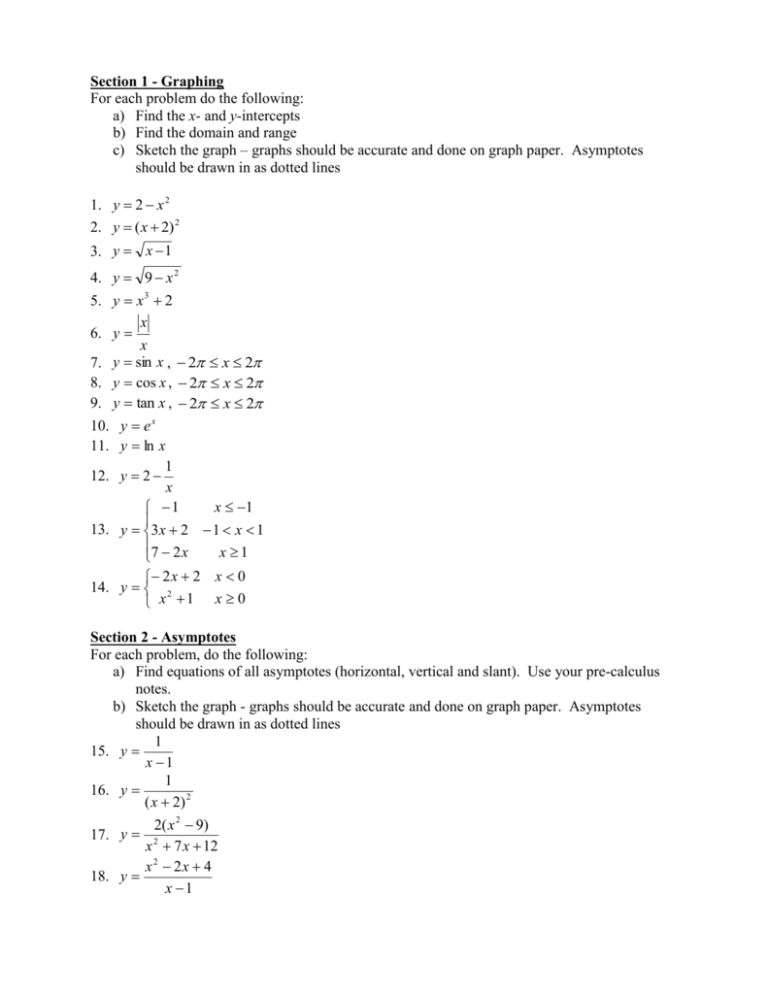
Section 1 - Graphing For each problem do the following: a) Find the x- and y-intercepts b) Find the domain and range c) Sketch the graph – graphs should be accurate and done on graph paper. Asymptotes should be drawn in as dotted lines 1. y 2 x 2 2. y ( x 2) 2 3. y x 1 4. y 9 x 2 5. y x 3 2 x 6. y x 7. y sin x , 2 x 2 8. y cos x , 2 x 2 9. y tan x , 2 x 2 10. y e x 11. y ln x 1 12. y 2 x x 1 1 13. y 3x 2 1 x 1 7 2 x x 1 2 x 2 x 0 14. y 2 x 1 x 0 Section 2 - Asymptotes For each problem, do the following: a) Find equations of all asymptotes (horizontal, vertical and slant). Use your pre-calculus notes. b) Sketch the graph - graphs should be accurate and done on graph paper. Asymptotes should be drawn in as dotted lines 1 15. y x 1 1 16. y ( x 2) 2 2( x 2 9) x 2 7 x 12 x2 2x 4 18. y x 1 17. y Section 3 - Inequalities Solve the inequalities and graph your solution on a number line. x 1 ()( ) 2 Example: x 1 0 ( x 1)( x 1) 0 1 x 1 ()( ) x 1 ()( ) so the solution is 𝑥 < −1 and 𝑥 > 1 because that is where the expression is greater than 0. Additional notes: Example: if x a then x a or x a Example: if x b then b x b Example: if x c then x c or x c 19. x 2 9 20. ( x 2) 2 ( x 1) 3 ( x 5) 0 21. x 2 x 12 0 (2 x 5)( x 1) 2 22. 0 ( x 2) 3 23. 2 3 8x 11 3x 2 0 24. x4 x3 5 25. x4 26. 7 x 5 27. 1 x 1 2 2 Section 4 – Trigonometric Equations a) Solve each equation. b) Give the exact answers in radians c) You may need to use your chapter 7 formula sheet or factor some of the expressions before solving 28. 29. 30. 31. 32. 33. 2 cos x 3 0 sin 2x 1 sin 2x cos x 2 cos 2 x 3 cos x 2 0 2 cos 2 x sin x 1 0 tan 2 x sec x 1 Section 5 – Algebraic Equations Find equations of the lines (in y mx b form) satisfying the given conditions. 34. 35. 36. 37. a line perpendicular to x 4 y 7 that passes through the point (3,4) a line with x-intercept a and y-intercept b a line parallel to y 5 that passes through the point (1,8) a line through the points (2,4) and (3,7) Section 6 – Optimization problems Solve each problem using your graphing calculator (see example). Give decimal answers correct to three decimal places (or exact if possible). Sketch what you saw on your graphing calculator (indicate the window size). Label where the answer is on your graph. Example: Find two positive numbers such that their product is 100 and their sum is a minimum. 100 Write two equations: 1. Sum x y and 2. xy 100 y . x 100 Substitute second equation into first equation. Sum x . x Graph this equation with your graphing calculator and use the minimum command to find what x value gives the smallest sum (you may have to change the window). In this problem x 10 . 38. Find two positive numbers such that their product is 192 and their sum is a minimum. 39. Find two positive numbers such that their product is 192 and the sum of the first plus three times the second is a minimum. 40. A rancher has 200 feet of fencing with which to enclose two adjacent rectangular corrals, as shown. What dimensions should be used so that the enclosed area will be a maximum? Start by labeling the sides and writing 2 equations. 41. A rectangular page is to contain 24 square inches of print. The margins at the top and bottom of the page are to be 1.5 inches and the margins on the left and right are to be 1 inch. What should the dimensions of the page be so that the least amount of paper is used? 42. The sum of the perimeters of an equilateral triangle and a square is 10. Find the dimensions of the triangle and square that produce a minimum total area. 43. Two posts, one 12 feet high and the other 28 feet high, stand 30 feet apart. They are to be stayed by two wires, attached to a single stake, running from the ground level to the top of each post. How far from the left post should the stake be placed to use the least wire? Section 7 – Logarithmic equations a) Solve the following problems using the properties of logs and exponents. b) Give answers to three decimal places. 44. log( 1 x) 3 45. ln( 1 / x) 2 46. ln( 4 x) 3 ln x 2 ln 2 47. 3e 2 x 5 48. xe x 2e x 0 1 49. Write the expression as a single log: log x 2 log y log z +2 2 a3 b 50. Let log z a 2, log z b 4, and log z c 1/ 5 . Find log z c5 Use the properties of logs to pull apart the expression before substituting. AP Calculus – AB summer assignment Please show all work – it should be clear and concise. Work should be done in pencil Graphs should be done on graph paper All work is due on the first day of school, Thursday September 6th. This will count as your first quiz for the marking period. Additionally, questions from this material may be on the first chapter test. You will receive several emails from me over the summer and please don’t hesitate to email me: jthomas@wwrsd.org In particular, you will receive an email with another example of the optimization problems – please make sure you attempt these to the best of your ability. Have a great summer!!!







